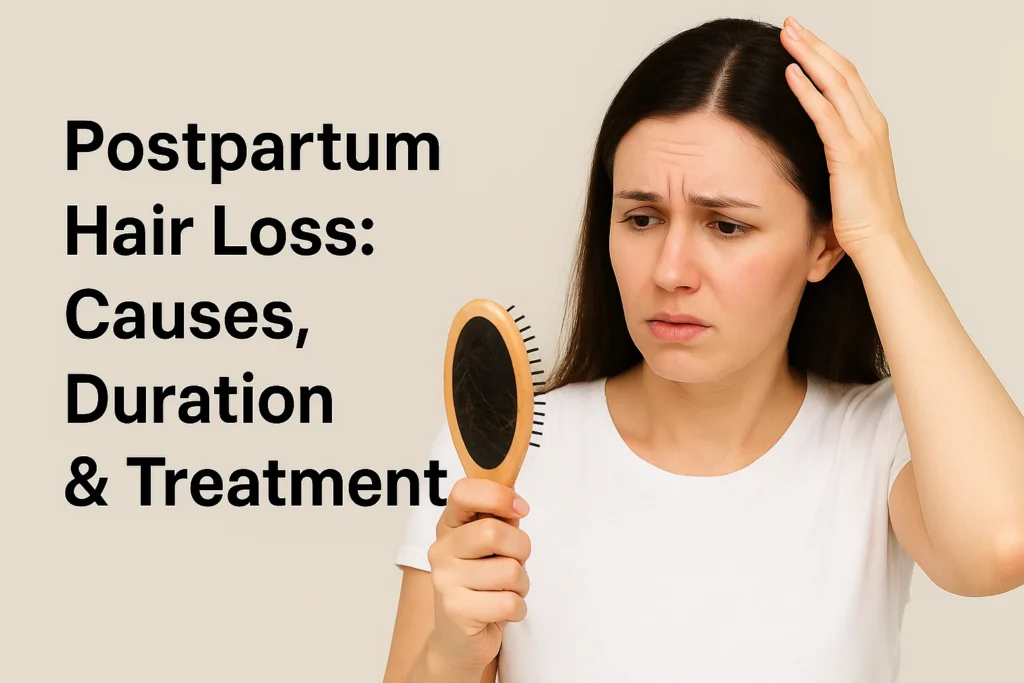Welcoming a baby into the world brings unmatched joy. However, alongside the joys of motherhood, many women encounter a surprising change: postpartum hair thinning. If you’re seeing more hair fall than usual during combing or showering, know that this is a widespread experience. This condition, though unexpected, is completely normal. Let’s explore why it happens, how long it typically lasts, and how you can effectively manage it.

What is Postpartum Hair Loss?
Postpartum hair loss, medically known as telogen effluvium, is a temporary form of hair shedding that many women face after giving birth. While not every mother experiences it, up to 50% notice their hair becoming visibly thinner in the months following delivery. This shedding may affect the entire scalp or focus on specific areas, especially around the temples and hairline.
Keep in mind, this isn’t the same as hereditary hair loss conditions like androgenetic alopecia—it’s a temporary phase triggered by physiological changes.
What Causes Postpartum Hair Loss?
Hormonal fluctuations are the main reason behind hair shedding after childbirth. During pregnancy, elevated estrogen levels keep hair in a prolonged growth stage, reducing daily hair fall. Once the baby is born and hormone levels drop rapidly, the hair that was “on hold” enters the shedding phase all at once.
Other Contributing Factors:
- Stress and sleep deprivation: Caring for a newborn can take a toll on your body and scalp health.
- Iron deficiency or low ferritin: Blood loss during labor may deplete iron stores, affecting hair follicles.
- Thyroid issues: Postpartum thyroiditis may cause either overactive or underactive thyroid, both of which impact hair growth.
- Poor postnatal nutrition: Skipping meals or consuming low-nutrient foods can delay recovery.
- Heavy bleeding during delivery: This can lower the iron and oxygen supply to the roots, impairing hair strength.
How Long Does Postpartum Hair Loss Last?
Most women begin to notice increased hair fall around 2–4 months postpartum, with the heaviest shedding happening around 4–6 months. The encouraging news? This is only temporary. In most cases, by the time your baby turns one, your hair growth patterns tend to stabilize and return to their usual rhythm.
Timeline: What to Expect
TimeframeWhat Happens
- 0–2 months Hair appears thicker due to pregnancy hormones
- 2–4 months. Shedding becomes noticeable in the brush or shower
- 4–6 months Peak hair fall, hair may look visibly thinner
- 6–12 months Hair regrowth picks up, and the shedding process slows down
- After 12 months, Hair fullness typically matches how it was before pregnancy
Postpartum Hair Loss Treatment Options
While you may not be able to stop the shedding completely, there are plenty of ways to support healthy hair regrowth:
1. Nourish from Within
Fuel your body with essential nutrients that promote strong, healthy hair:
- Eat foods rich in iron, protein, biotin, zinc, and vitamin D
- Include leafy greens, lentils, eggs, nuts, fish, and citrus fruits
- Get healthy fats like omega-3s from flaxseeds, chia seeds, or oily fish
- Stay hydrated and avoid processed/junk food
2. Supplements (With Medical Approval)
- Postnatal multivitamins
- Biotin and collagen (to support keratin production)
- Iron supplements (if you’re diagnosed with low iron)
- Maintaining adequate levels of vitamin D and B12 can boost energy levels and support healthier hair recovery
3. Gentle Hair Care Routine
- Avoid tight hairstyles, heat styling, or excessive brushing
- Use a wide-tooth comb and pat dry with a soft microfiber towel
- Switch to sulfate-free shampoos and use hydrating conditioners
- Sleep on satin or silk pillowcases to reduce friction
4. Scalp Care & Massage
- Regular oil massages improve circulation and relieve scalp tension
- Consider using natural oils such as rosemary, almond, coconut, or castor oil
- You can add essential oils like peppermint or lavender for added benefits
5. Medical Treatments (If Hair Loss Is Severe)
Consult a dermatologist for these options:
- Topical Minoxidil (only after breastfeeding is complete and under medical advice)
- PRP Therapy (Platelet-Rich Plasma injections)
- Low-Level Laser Therapy (LLLT)
- Blood tests to check for thyroid, estrogen, or prolactin imbalances
6. Lifestyle Modifications
- Practice mindfulness, deep breathing, or gentle yoga
- Consider postnatal massage for circulation and relaxation
- Ensure you’re staying well-rested and hydrated—don’t hesitate to seek support from family or friends when needed
Is Your Postpartum Hair Loss Normal?
Hair shedding that begins within 2–4 months postpartum and tapers off by 12 months is usually normal. However, consult a healthcare professional if:
- Hair loss is extreme or still ongoing after a year
- You observe bald patches or a receding hairline
- You experience symptoms like fatigue, cold intolerance, or mood swings (may indicate thyroid issues)
- You have a genetic predisposition to hair thinning or a family background of conditions like female-pattern hair loss
Will My Hair Grow Back?
Yes, it will. Typically, within six to twelve months post-delivery, hair growth resumes its usual cycle and density. In some women, the new hair may come back with a different texture—curly, finer, or thicker—which is completely normal.
Can You Prevent Postpartum Hair Loss?
Although complete prevention isn’t always possible, you can take proactive measures to lessen the intensity:
- Start postnatal supplements early and stick to them consistently
- Create a calm environment using meditation or short walks
- Ensure you’re eating enough protein, as it plays a vital role in producing keratin, the key structural component of hair
FAQs About Postpartum Hair Loss
Q1. How long does postpartum hair loss last?
Usually 4 to 6 months, but it can last up to a year in some women.
Q2. What is the best treatment for postpartum hair loss?
A combination of a nutrient-rich diet, gentle care, and supplements. For excessive loss, consult a dermatologist.
Q3. Does every woman experience postpartum hair loss?
Not always, but it’s extremely common among new mothers.
Q4. Does breastfeeding cause hair loss?
Breastfeeding itself doesn’t cause it, but the extra nutritional demands may worsen it if not addressed.
Q5. When should I worry?
If hair loss persists beyond a year or if you see bald spots or other symptoms, consult your doctor.
Q6. Will it be the same for every pregnancy?
No, the intensity and duration can vary between pregnancies due to different hormonal and lifestyle factors.
Q7. Can it affect mental health?
Yes, it can impact confidence and cause stress. Seeking emotional support or professional guidance can help.
Final Thoughts
Postpartum hair loss can feel frustrating and even disheartening, but it’s a temporary phase. With proper nutrition, self-care, and patience, your hair will regain its strength and volume. Celebrate your body’s journey—it has created life. And with time and care, you’ll feel more like yourself again.
Lotus Femcare is here to support your journey through motherhood—one beautiful strand at a time.
Also Read: 11 Best Shampoos for Hair Loss in Women



